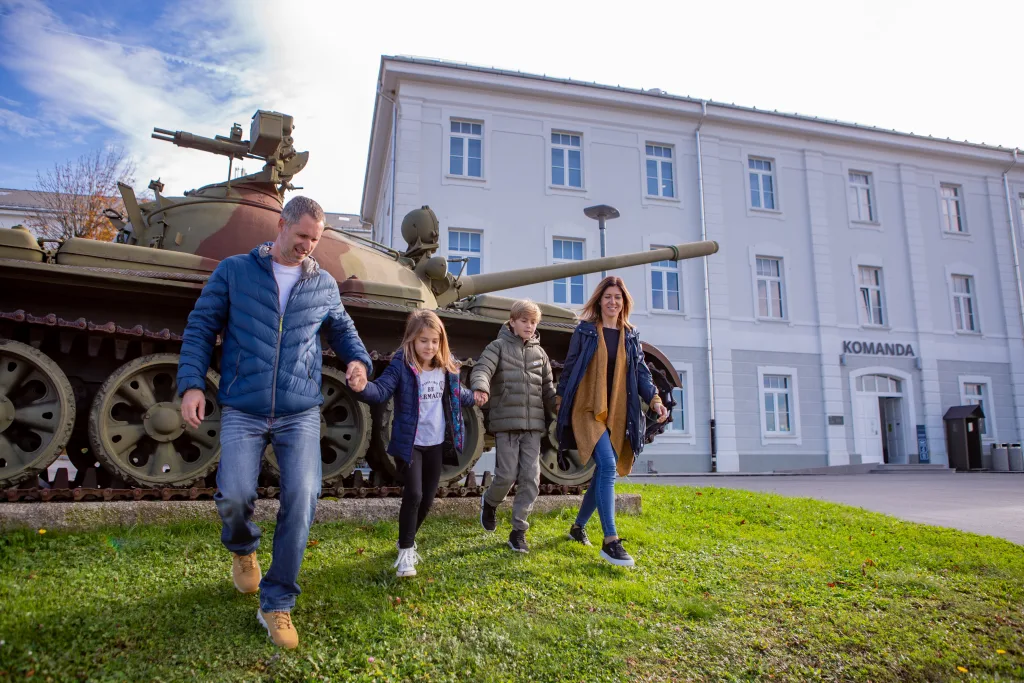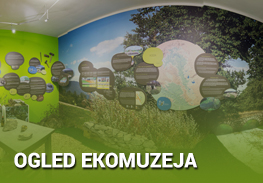20th anniversary of the idea of establishment in the Park of Military History
Twenty years ago, on May 9, 2004, just a few days after the Republic of Slovenia joined the European Union, on the Day of Europe and the municipal day of Pivka, the idea was born to convert abandoned, decaying barracks on the outskirts of Pivka into a military museum. The bold idea had little chance of realization. Still, the Municipality of Pivka recognized it as a developmental opportunity, the Ministry of Defense assessed the project as feasible, a dedicated team embarked on the work, and European cohesion funds opened unforeseen possibilities… Designers got to work, construction machinery buzzed, and the Military Museum of the Slovenian Armed Forces began the restoration of its first exhibits.
From its modest beginnings at its opening in 2006 to the present day, the Park of Military History has developed into the largest museum complex in the country and one of the most visited museums in the state. With its registration in the museum register at the Ministry of Culture in 2019 and obtaining authorization to perform state public museum services in 2022, its role in presenting military movable and intangible cultural heritage was also confirmed at the national level.
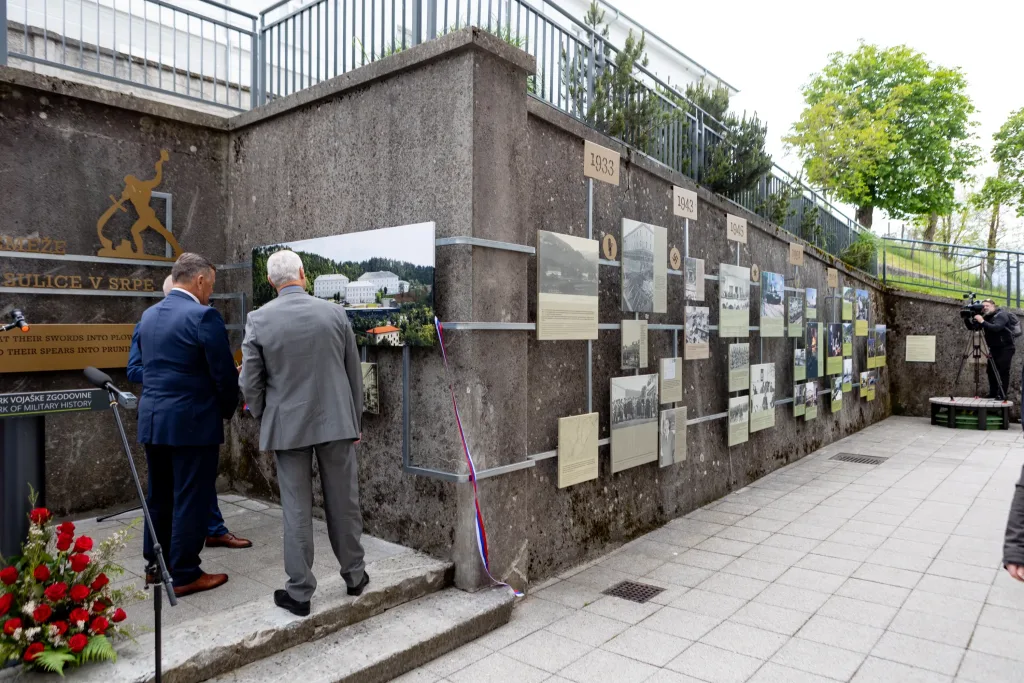
In commemoration of the twentieth anniversary, which marked the inception of such a daring project, a museum monument with a photographic exhibition depicting the development of the museum complex was erected in the Park of Military History.
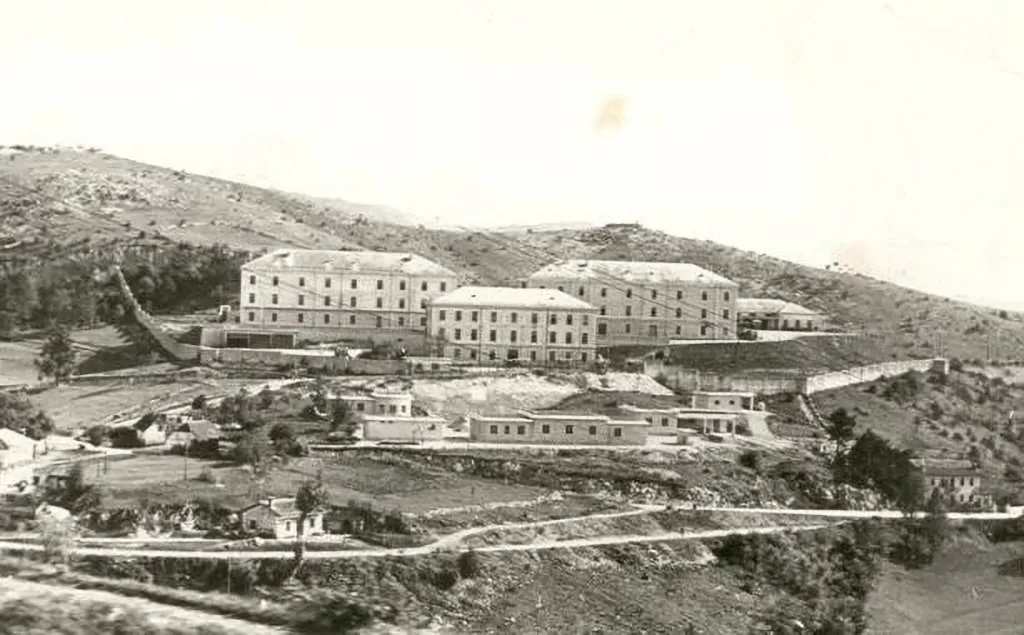
The exhibition, titled “They shall beat their swords into plowshares and their spears into pruning hooks (Isaiah 2:4),” visually presents the rich history of the former barracks on the outskirts of Pivka from its construction in the 1930s to its gradual decline after Slovenian independence. A series of photographs in the second thematic section highlights key milestones in the story of the Park of Military History, whose establishment architecturally preserved the impressive barracks complex from final decay. The exhibition’s author is the director of the Park, Mag. Janko Boštjančič. The construction and exhibition were designed by Barbara Sirk and Žiga Okorn from the company Uvid.si, and executed by the companies Maher and O.K.V I R.
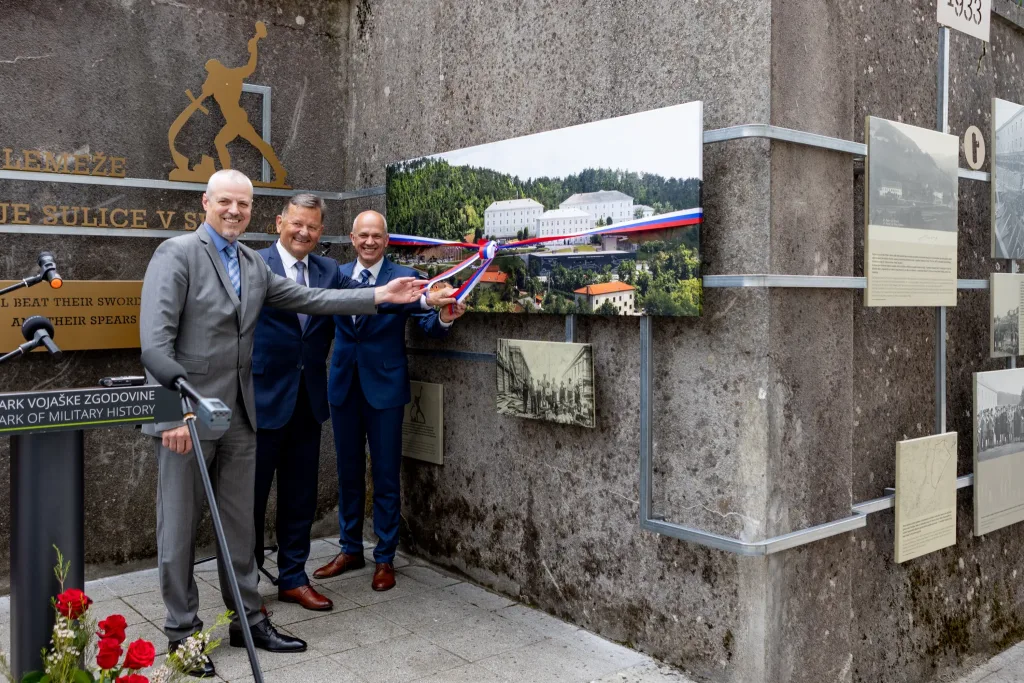
On May 8th, at a brief ceremony in the Park of Military History, Minister for Cohesion and Regional Development Dr. Aleksander Jevšek unveiled a museum monument with a photographic exhibition. In light of the twentieth anniversary of Slovenia’s accession to the European Union, the Park of Military History, as highlighted, represents a success story due to the recognition of new development perspectives and successful utilization of European funds while also supporting the state policy of decentralization and coherent regional development. The director of the Park, Mag. Janko Boštjančič summarized the museum’s mission and the exhibition’s message with the words: “For the name of the exhibition and indeed the entire commemoration of the 20th anniversary of the Park’s idea, we chose a biblical quote: ‘They shall beat their swords into plowshares and their spears into pruning hooks.’ Isaiah’s prophecy from 2,750 years ago seemed highly appropriate to us, as it eloquently encapsulates what we are doing here, transforming weapons intended for destruction and killing into developmental and touristic potential. In a time when swords and spears are being forged with full force around the world again, this message is even more important. We have inscribed Isaiah’s words into metal so that they can testify to future generations of our firm belief that a better world is possible and that peace and justice will ultimately prevail among nations.”
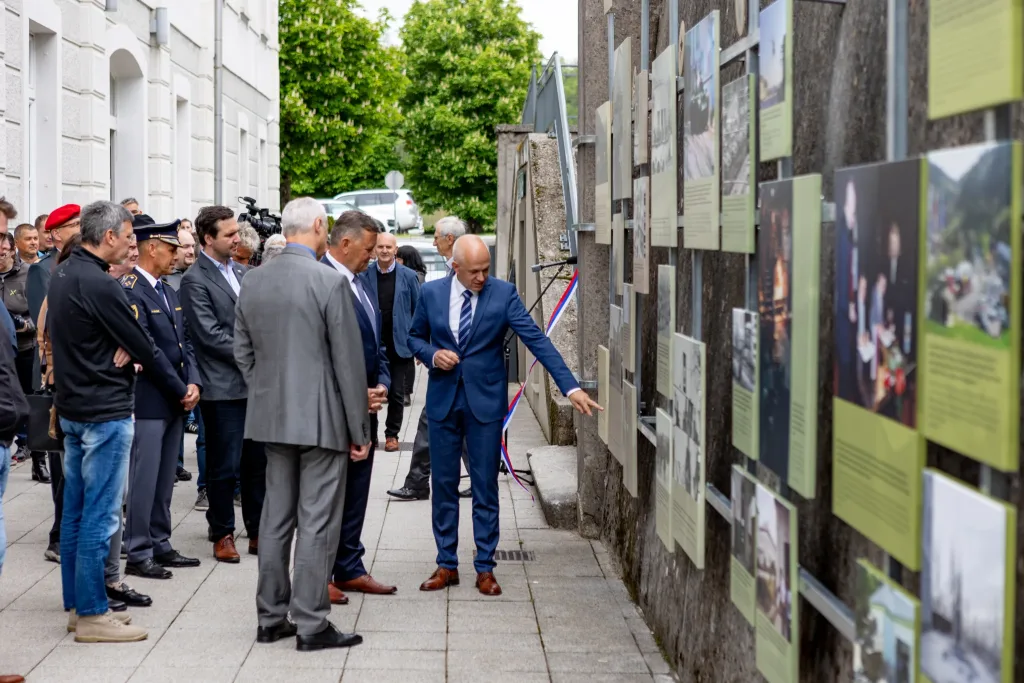
The opening of the exhibition was followed by a panel discussion with the creators of the idea from twenty years ago and key actors in the rapid and successful development of the Park of Military History. Memories of the unwavering enthusiasm of the responsible individuals at that time and the challenging formal-legal path to the establishment of the Park were presented by the former commander of the Pivka barracks, Major General Roman Urbanč, who is now the representative of the Republic of Slovenia to the EU and NATO, Mayor of the Municipality of Pivka Robert Smrdelj, and the director of the Park, Mag. Janko Boštjančič, emphasizing the exemplary cooperation between the local community and the Ministry of Defense of the Republic of Slovenia or the Slovenian Armed Forces. The discussion, moderated by Marjana Grčman, also involved Colonel Marko Hlastec, the Chief of the Military Museum of the Slovenian Armed Forces, Dr. Jedrt Vodopivec, conservator, Sandi Curk, the commander of the regional Civil Protection Headquarters for Notranjska, as well as representatives of the Walk of Peace Foundation in the Soča Valley, Škocjan Caves Park, and the Regional Development Agency Green Karst as long-standing partners of the Park of Military History. In addition to sincere congratulations to the Park of Military History, they emphasized its important role in today’s world and its contribution to the development of the museum profession and the tourist recognition of the region and the wider area.
Pivka marks Slovenian-British Alliance
The Park of Military History received two precious historical artifacts with a brief ceremony on May 5th. These include a sword presented to the Deputy Supreme Allied Commander Europe from 1994 to 1998, General Sir Jeremy Mackenzie, in gratitude for his assistance to the Slovenian Army in approaching the NATO alliance. The sword was gifted by the Chief of the General Staff of the Slovenian Army, Major General Albin Gutman. Additionally, the park received a regimental kilt of the British Army in the ‘Mackenzie’ tartan pattern, originally worn by the Seaforth Highlanders and later by the Queen’s Own Highlanders. The sword was presented to the Park of Military History for museum purposes on the occasion of the 75th anniversary of the NATO alliance and the 20th anniversary of Slovenia’s accession to the North Atlantic Treaty Organization by Dr. Aleš Musar, the husband of the President of the Republic of Slovenia. Dr. Musar acquired the sword some time ago and decided to donate it to the Military History Park, while the kilt was gifted to the Park by the British Embassy on the double anniversary of the NATO alliance. The event, attended by donors Dr. Aleš Musar and Her Excellency Tiffany Sadler, the British Ambassador to Slovenia, also saw the presence of the Mayor of the Municipality of Pivka, Robert Smrdelj, an advisor in the cabinet of the Minister of Defense of the Republic of Slovenia, and the President of the Association of Slovenian Officers, Major General Dobran Božič, as well as the British Defense Attaché, Lieutenant Colonel Christopher Day. Adding a Scottish touch to the ceremony, musician Byron Stirton from the Scottish Royal Fourth Battalion military orchestra performed on bagpipes.
In the late afternoon, a memorial ceremony followed the anniversary of the crash of the Spitfire MH980 airplane near the village of Suhorje in the Brkini region. These days mark the 79th anniversary since the British Spitfire MH980 aircraft tragically crashed near the village of Suhorje, on the edge of the Brkini region. This incident resulted in the untimely loss of the life of a young pilot, Sergeant Edmund Ramsbotham of the British Royal Air Force, just before the end of the war.
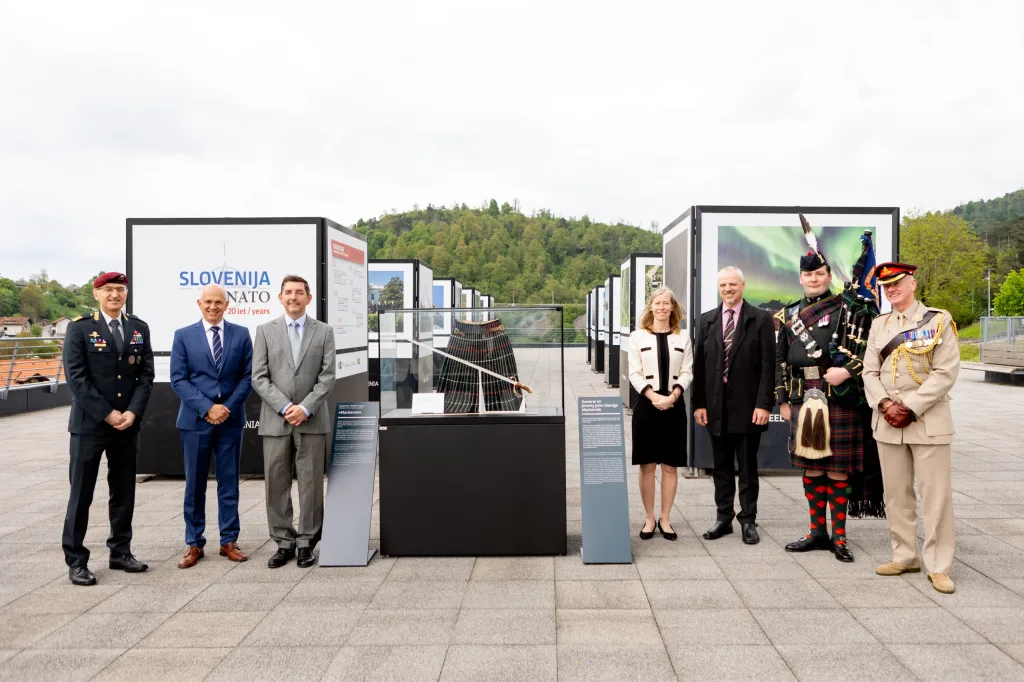
The 21-year-old pilot was a member of the 249th Squadron of the RAF, one of the most renowned fighter units of the British Royal Air Force. At the end of April 1945, when the majority of Europe had already been liberated, the squadron assisted Yugoslav partisans in the final battles by attacking German transports on roads and railways. Sergeant Ramsbotham took off with the Spitfire MH980 aircraft from Canne airfield in Italy on April 29, 1945, refueling at Prkos airfield near Zadar, then flying to Trieste in search of enemy units. On the return journey, he attacked an enemy truck with ammunition during a low-level flight, but the aircraft was hit by the explosion of the truck, causing it to crash near Suhorje shortly afterward. The body of the young English pilot was decently buried by the villagers in the local cemetery. Soon after the war, his remains were exhumed by British military authorities and reburied at the military cemetery in Belgrade, where he rests to this day.
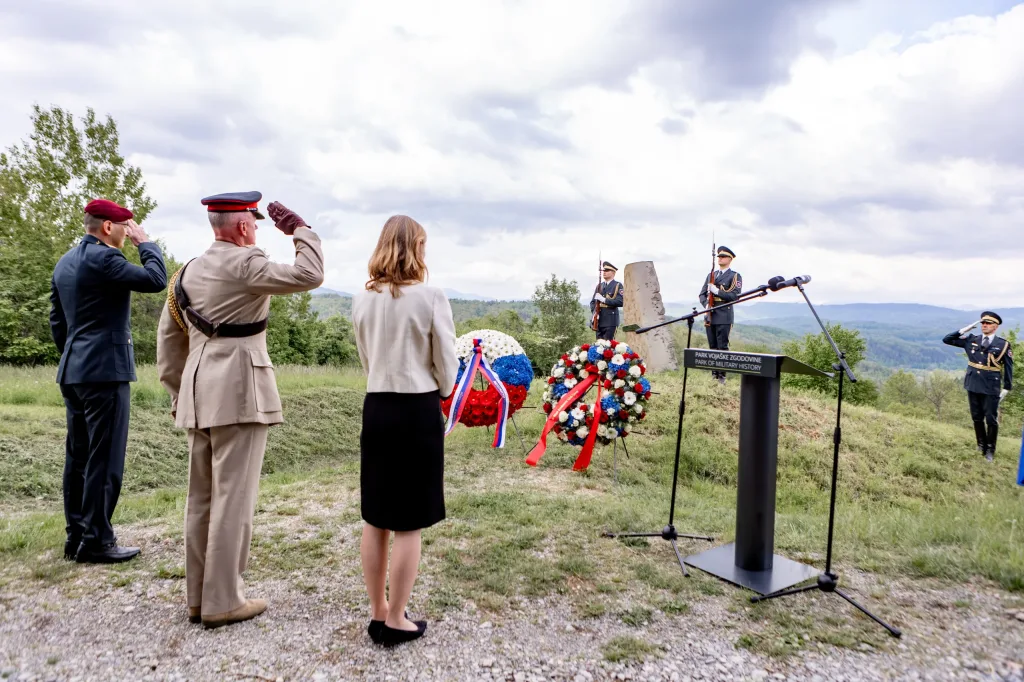
The memory of this tragic event in Suhorje has never completely faded. In 2021, at the initiative of the villagers of Suhorje, the Military History Park erected a monument at the crash site, bearing witness to the sacrifice of the young RAF sergeant, for both the locals and visitors. The monument was created by the academic sculptor Jurij Smole.
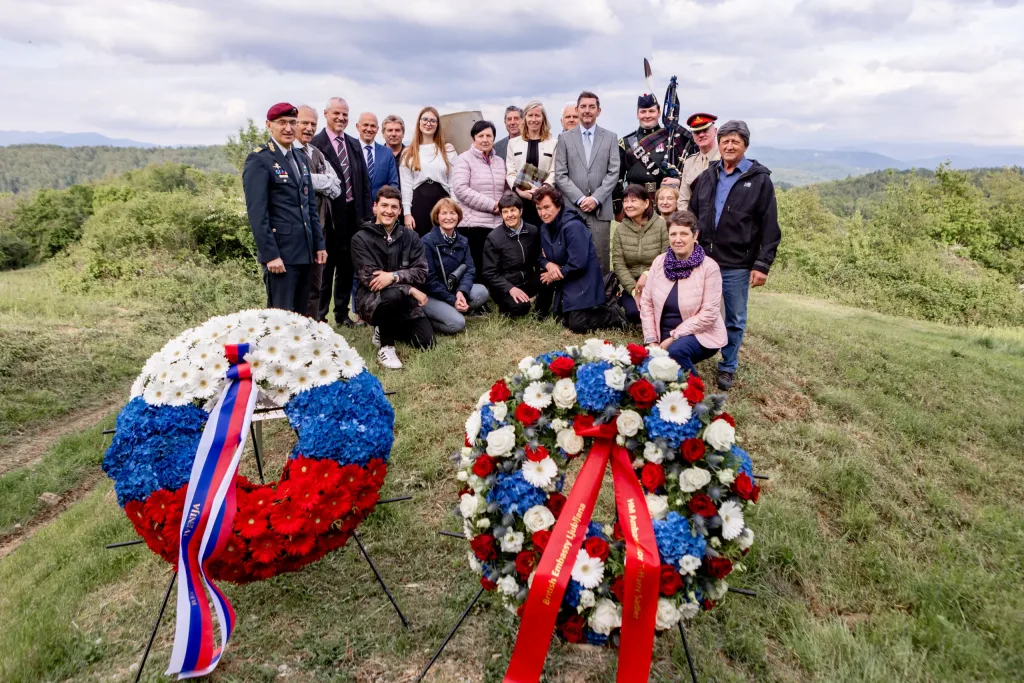
Every spring, around the anniversary of the crash, the Park, in collaboration with the British Embassy in Slovenia and the Ministry of Defense of the Republic of Slovenia, organizes a memorial ceremony at the event site. This year, as part of the ceremony, British Ambassador to Slovenia Her Excellency Tiffany Sadler and the advisor in the cabinet of the Minister of Defense of the Republic of Slovenia and President of the Association of Slovenian Officers, Major General Dobran Božič, paid tribute to the deceased pilot and the fallen aircraft by laying a wreath at the monument near the village of Suhorje.
Opening hours during the month of May
The Park of Military History will be open in May from Monday to Friday between 10 a.m. and 4 p.m., and on Saturday and Sunday between 10 a.m. and 6 p.m.
For a tour of the interior of the submarine and a flight simulator experience with MiG-21 or Spitfire aircraft as an additional museum offering, prior reservation of a time slot is mandatory. You can make a reservation by calling +386 (0)31 775 002 or by email at [email protected].
The Park of Military History will once again host the international miniature model festival “World in Miniature” this year, on May 25, 2023, organized by the `Svet v malem` Society. The event will gather hundreds of modelers and miniature enthusiasts from various countries who will compete for the best miniature in different categories. Intricate miniaturized versions of military vehicles, vessels, and scenic displays will complement the museum’s exhibition of military technical heritage on that day. As part of the festival, there will also be demonstrations of model making techniques and a modelers’ flea market.
Also on May 25th, there will be a meeting of vintage Zastava vehicles in the Park organized by the Zastava Club of Slovenia.
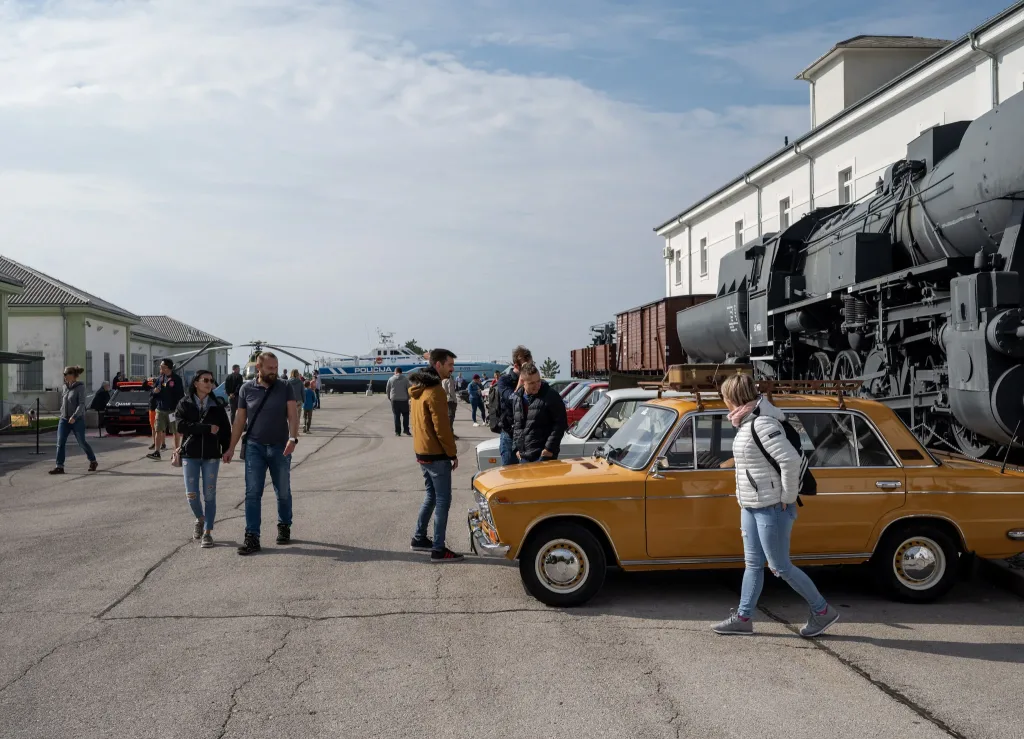
On Sunday, May 26th, you are invited to participate in a hike along the Circular Path of Military History in Pivka.
Opening Hours During May Day Holidays
The Park of Military History will be open during the May Day holidays (April 27th – May 5nd) from 10:00 AM to 6:00 PM.
As an additional museum offer, visiting the interior of the submarine and experiencing the flight simulator with MiG-21 aircraft requires prior reservation of the time slot. You can make a reservation by calling +386 (0)31 775 002 or by emailing [email protected].
Opening of the exhibition “NATO 75 YEARS/SLOVENIA AND NATO 20 YEARS” and a round table discussion commemoratees the double jubilee of the NATO alliance
At the Park of Military History Pivka, an exhibition titled “NATO 75 YEARS/SLOVENIA AND NATO 20 YEARS” and a round table discussion were organized to commemorate the double jubilee of the NATO alliance.
This year marks the 75th anniversary of the establishment of the NATO alliance, and Slovenia also celebrates the 20th anniversary of joining the North Atlantic Treaty Organization. In 2004, the Republic of Slovenia, alongside Bulgaria, Estonia, Latvia, Lithuania, Romania, and Slovakia, became a full member of NATO following a decisive referendum supported by its citizens. This membership brought a stable security and political environment to Slovenia and expanded the operational dimension of the Slovenian Armed Forces.
In collaboration with the Government Communication Office of the Republic of Slovenia and the Ministry of Defense, and with the support of the United States Embassy in Slovenia, the Park of Military History prepared an exhibition to inform visitors about NATO’s operations, its role, and the significant advantages that NATO membership provides to Slovenia. The Park joined a series of events and commemorations at the highest state level in light of Slovenia’s approaching twentieth anniversary of formal entry into NATO.
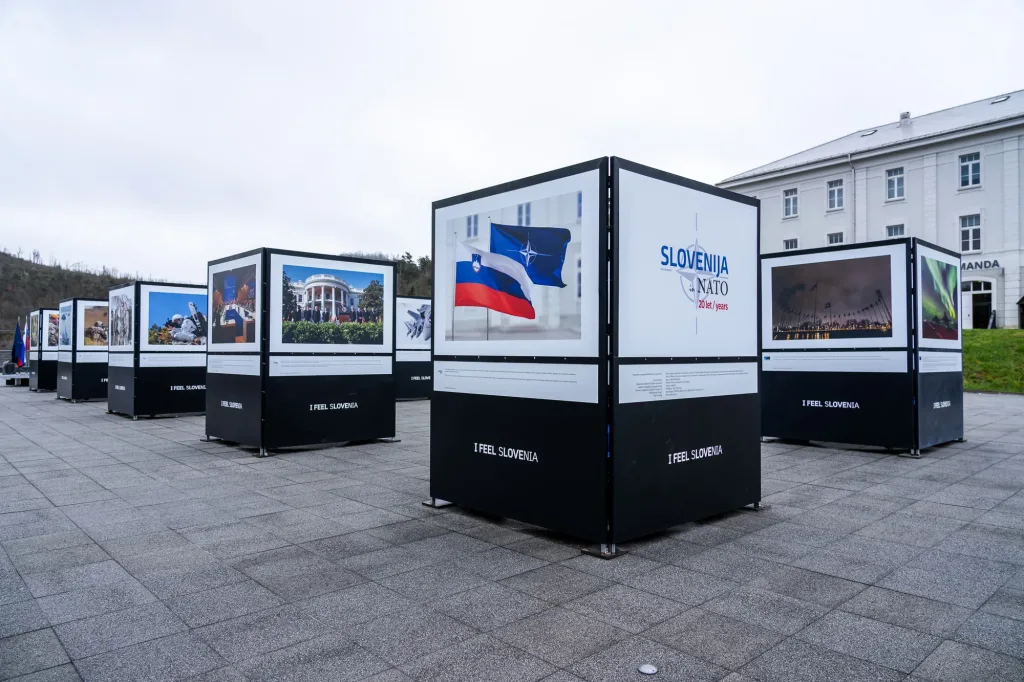
The new photographic exhibition consists of two main sections. The first, titled “NATO 75 YEARS,” presents the history of the alliance, its development, and military power. The second part, titled “SLOVENIA AND NATO 20 YEARS,” depicts Slovenia’s path towards NATO and the importance of the NATO alliance for Slovenia. The director of the Park of Military History, mag. Janko Boštjančič, curated the exhibition. The content panels were designed by Barbara Sirk and Žiga Okorn from Uvid.si, and the comprehensive museum setup for placement in external cubes at the entrance to the Park was designed by Irena Kogoj from the Government Communication Office of the Republic of Slovenia.
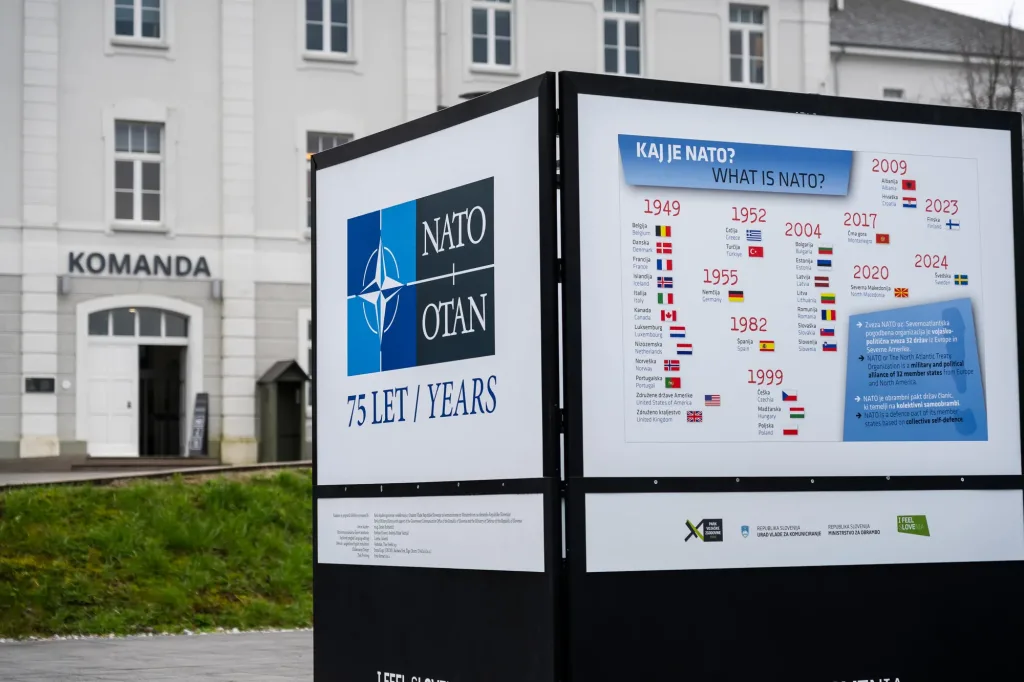
The exhibition “NATO 75 YEARS/SLOVENIA AND NATO 20 YEARS” was inaugurated on March 27 at a brief ceremony by the State Secretary at the Ministry of Defense, Dr. Damir Črnčec. He emphasized the significance of opening an exhibition about NATO and Slovenia’s role within it, particularly within a museum collection showcasing the war of ’91. The location and content of the exhibition bear importance as they reflect Slovenia’s historical experience and the significance of the North Atlantic defense alliance from the decades following World War II to the present day. Petra Bezjak Cirman, the director of the Government Communication Office of the Republic of Slovenia, also addressed the audience, commending the Park of Military History for organizing an exhibition that informs the public about NATO’s operations while encouraging reflection on contemporary challenges and the alliance’s future development, where prioritizing efforts for peace remains essential. Director mag. Janko Boštjančič highlighted the broader perspective of the exhibition, stating that NATO represents the most potent military alliance in human history, providing security to a significant portion of Europe and shaping global events.
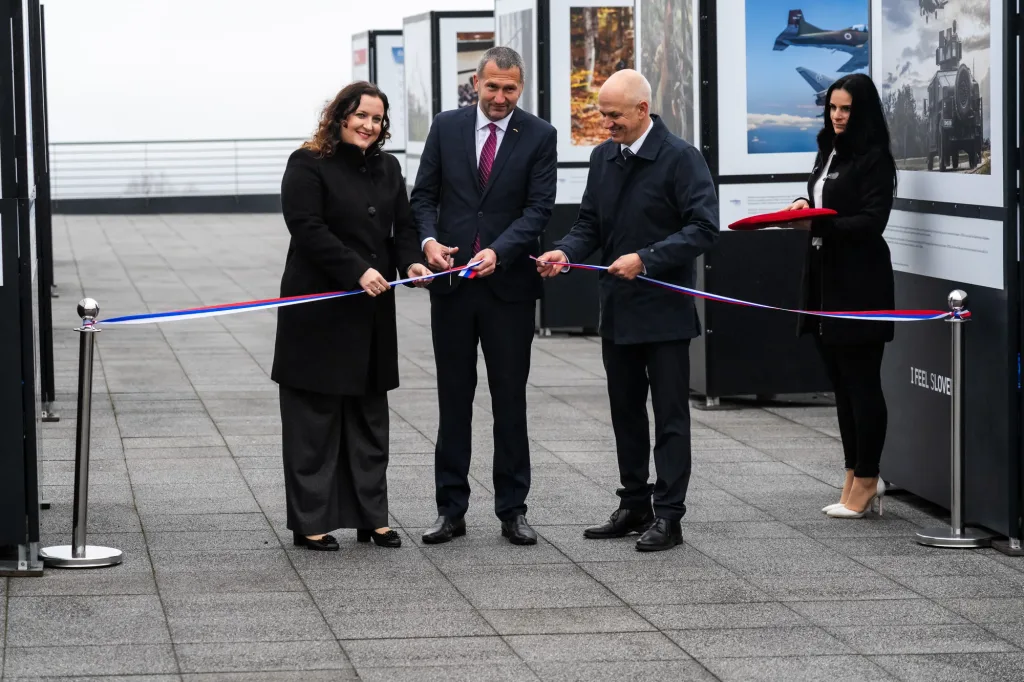
The exhibition opening was followed by a round table discussion titled “NATO 75 Years – Role and Significance in the Past/Present/Future” where invited speakers shared their thoughts on the benefits of NATO membership and the challenges faced by the North Atlantic Treaty Organization despite its decades-long existence. Dr. Damir Črnčec, the State Secretary at the Ministry of Defense of the Republic of Slovenia; Tiffany Sadler, the Ambassador of the United Kingdom of Great Britain and Northern Ireland to the Republic of Slovenia; Dr. Andrij Taran, the Ambassador of Ukraine to the Republic of Slovenia; and Dr. John Marshall Callahan, a professor of international relations at New England College in the USA, presented their views on the current state and vision for the future development of the NATO alliance.
In addition to the participating guests, several ambassadors and other high-ranking diplomatic and military representatives from NATO member states attended the event, along with numerous domestic representatives from the Ministry of Defense, the Slovenian Armed Forces, the Ministry of Foreign Affairs, the Government Communication Office of the Republic of Slovenia, and the Municipality of Pivka.
Working hours during the Easter holidays
The Park of Military History will be open on Saturday and Sunday, March 30th and 31st, from 10 a.m. to 4 p.m. and on Easter Monday, April 1st, from 10 a.m. to 5 p.m.
PRIOR RESERVATION is REQUIRED for the tour of the submarine interior and/or a test on the MiG-21 simulator.
You can make a reservation at 031 775 002 or [email protected].
